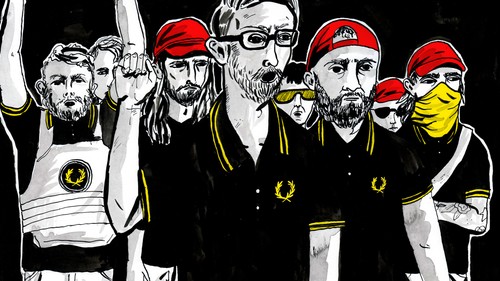The classic Fred Perry polo hasn’t changed much since its debut in the 1950s.
Launching first in white, then in a black-and-gold colour-way intended to subvert the classic Wimbledon white kit, Fred Perry has become part of British cultural history. It’s been worn by everyone from mods and rudeboys to indie kids and icons like Mike Skinner, Amy Winehouse and Skepta.
But for all of its cultural legacy, Fred Perry can’t seem to escape a periodic adoption by violent and/or facist groups, who have worn its leaf laurel polos since the 1960s. This includes the National Front, the EDL and, most recently, the Proud Boys, a men’s only neo-fascist organisation whose members have made the black and yellow polo their uniform, prompting Fred Perry to pull it from stores at the end of September.
In a statement at the time, the brand said: “It is incredibly frustrating that this group has appropriated our black and yellow twin-tipped shirt and subverted our laurel wreath to their own ends. We are proud of its lineage and what the laurel wreath has represented for over 65 years: inclusivity, diversity and independence.”
Proud Boys founder Gavin McInnes – who co-founded VICE, but left in 2008 and has had no affiliation with the company since then – once explained his aim in wearing the polo was to “align his group with the working-class toughness of the late-60s hard mods”.
Since Fred Perry began, its fanbase has been divided between people who love the style, grassroots music and alternative subcultures Fred Perry represents, and knuckleheads who want to boot your head in. How, throughout its 70-year history, has one brand been so vastly and regularly misappropriated?
The starting point is the skinhead culture of the 1960s. Having been a tennis uniform in the 50s, Fred Perry was adopted by early British skinheads, who were firmly anti-establishment.
“We aspired to tough guys on the estate and football hooligans,” says Symond Lawes, an actor and lifelong skinhead. “We were anti-school teachers, police… anyone who told us what to do, really.”
Back then, being a skinhead was about being inclusive and embracing your blue-collar upbringing, rather than kicking anyone’s head in.
Read full article




No comments:
Post a Comment
Note: only a member of this blog may post a comment.